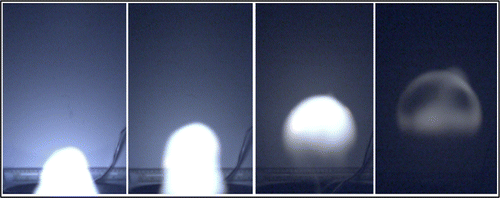New insights into the one-in-a-million lightning called 'ball lightning'

One of the rare scientific reports on the rarest form of lightning—ball lightning—describes better ways of producing this mysterious phenomenon under the modern laboratory conditions needed to explain it. The new study on a phenomenon that puzzled and perplexed the likes of Aristotle 2,300 years ago and Nikola Tesla a century ago appears in ACS' The Journal of Physical Chemistry A.
C. Michael Lindsay and colleagues explain that ball lightning consists of a floating, glowing ball that may drift eerily through the sky and then explode violently, sometimes injuring people and damaging buildings. The balls can range in size from a garden pea to globes several feet in diameter and glow for up to 10 seconds. Since it occurs only once in every million lightning bolts, natural ball lightning cannot be studied with scientific instruments.
Like Tesla in 1900, Lindsay and colleagues did their research by producing artificial ball lightning in the laboratory.
They describe experiments that led to more effective ways of making ball lightning, essential for further insights into the phenomenon, and techniques that made the fireball last longer so that observations could continue.
They developed a special video technique that reveals more information than ever before about the structure of the lightning balls and how they move.
More information: "Further Insight into the Nature of Ball-Lightning-Like Atmospheric Pressure Plasmoids" J. Phys. Chem. A, Article ASAP DOI: 10.1021/jp400001y
Abstract
Known since antiquity, ball lightning is a natural, long-lived plasma-like phenomenon associated with thunderstorms and is not well understood due to its rarity and unpredictability. A recently discovered laboratory phenomenon with striking similarity to ball lightning is observed when a high-power spark is discharged from a cathode protruding from a grounded electrolyte solution. Whereas several investigations of these long-lived plasmas have been reported over the past decade, the underlying chemical and physical processes are still unknown. The present work attempts to gain further insight into this phenomenon by examining the effect of electrolyte pH on the plasmoid and observing the chemical and physical structure of the plasmoid using high-speed schlieren videography and FTIR absorption spectroscopy. The results indicate that the lifetime and size of the plasmoid slightly increase as the pH of isoohmic electrolyte solutions deviate from neutrality. The observed absorption spectra of the plasmoids exhibit absorption cross sections in the 620–700, 1500–1560, 2280–2390, and 3650–4000 cm–1 ranges, the last attributed to the presence of water clusters. Finally, schlieren images revealed a single, sharp density gradient at the boundary layer of the top and sides of the expanding ball-shaped plasmoid, and turbulent mixing below the ball.
Journal information: Journal of Physical Chemistry A
Provided by American Chemical Society


















